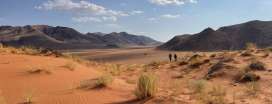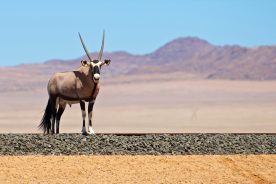Our grading system explained
Namibia

Show me:
1 Holiday
- Walk on the world famous dunes at Sossusvlei and explore the Skeleton Coast
- Relax in the attractive coastal town of Swakopmund and take a wildlife cruise in Walvis Bay
- Track desert-adapted elephant, rhino and pangolin
- Go on safari in spectacular Etosha National Park
- Stay at carefully selected lodges with bags of comfort and character
Flight inclusive from £6595, Land only from £4995
- 1
Introduction
Namibia is such an exciting and dramatic destination! It has some of the most amazing landscapes anywhere on the planet: Vast deserts, said to be the oldest in the world, some of the highest and most spectacular sand dunes found anywhere, bleached white pans where the stark black skeletons of trees are all that remain of long disappeared wetlands, vast landscapes of sculpted red rock, eroded over the millennia, canyons with towering rock walls, a rugged Atlantic coastline with strange lichen fields, ghostly shipwrecks and ocean fogs, and finally to top it all off, one of the greatest game parks in Africa, where you can expect to see the most amazing display of wildlife and birds. As if that was not enough, Namibia has been inhabited since prehistoric times and has one of the largest concentrations of prehistoric rock engravings on the African continent.
Namibia is located on the west coast of South Africa. It is one of the driest and most sparsely populated countries on earth. It has the least rainfall of any country in sub Saharan Africa and has famously clear skies and abundant sunshine. Although inhabited since pre-historic times by the San, Africa’s first people and its oldest culture, and later by Bantu peoples who migrated into the region in the 14th century, in colonial times it was part of the German Empire and was known as German West Africa. German rule ended with the First World War and Namibia is now an independent republic, but there are still echoes of this German heritage to be seen in the architecture of towns such as Windhoek and Swakopmund, and in a traditional fondness for beer in the country.
A visit to Namibia offers great variety and our new Gentle Walking & Wildlife Namibia holiday combines visits to some of the most spectacular parts of the country with easy-paced walks on most days for a more in depth look at the countryside, as well as opportunities to search for wildlife on foot and by safari vehicle. The country has a good infrastructure and a well-developed tourism industry and offers a good standard of accommodation so you will always be comfortable.
The capital, Windhoek is known for its laid back atmosphere and German architecture and is well worth exploring. South of Windhoek you may visit the Tsaris Mountains, a small mountain range noted for its interesting geology, scenic plateau and rugged canyons, as well as for its good wildlife and excellent birdwatching opportunities. Further south in the Namib Desert is Sesreim which has some of the most iconic landscapes of Namibia. Here you can walk through the world famous dunes of Sossusvlei and Deadvlei, some of the highest and most spectacular in the world, where amazing burnt-orange sand dunes contrast against the white of bleached silvery pans below. Sunrises and sunsets over the Namib Desert are truly mesmerizing – it is a world of vast spaces, endless horizons and jagged mountains.
Journeying to the coast you will see a wealth of bird and marine life at Walvis Bay, while lively Swakopmund town is nowadays a popular resort, characterized by 19th century German colonial architecture, galleries and shopping and a lively restaurant scene. North of Swakopmund is the desolate Skeleton Coast, where the cold waters of the Atlantic meet the Namib Desert resulting in spooky ocean fogs which have caused many a shipwreck. Continuing into mountainous Damaraland with Mount Brandberg its highest point, you find a spectacular region which is famous for its desert-adapted wildlife such as desert-dwelling elephants and black rhinos which inhabit these near barren landscapes. Ancient man also lived here in prehistoric times, leaving behind ancient rock paintings and at Twyfelfontein, some of the best-preserved etchings on the continent.
Games drives to spot the superb variety of wild life in Etosha National Park is a must see highlight of any visit to Namibia, while a visit to AfriCat at Okonjima will give you unparallelled opportunities to see remarkable animals in the wild, as well as an insight into unsparing local conservation efforts.
In short, whether it’s the massive sand dunes of Sesriem, the extraordinary eroded rock formations of Damaraland, the ghostly Skeleton Coast, or the teeming wildlife of one of Africa’s largest game parks, a trip to Namibia is a perfect choice for those in search of spectacular landscapes and wilderness.
Key Facts
Capital city: Windhoek
Population: 3.1 million – one of the most sparsely occupied countries in the world.
Size of country: 824,292 square kilometres
Currency: Namibian Dollar - $ or N$ - with same value as South African Rand.
Power supply: 220/240 volts
Sockets: Electrical outlets are round 3 pin – 15 amp type (Type D or M).
Language: English is the official language of Namibia. Up toil 1990, English, German, and Afrikaans were official languages. Today the majority of Namibians can speak and understand English and Afrikaans. Oshiwambo is the most widely spoken language.
Time difference: GMT. During summer months Namibia is 1 hour ahead of the UK.
Visas: From 1 April 2025 you need a visa to visit Namibia. UK passport holders can get a visa on arrival. Either apply when you arrive or you can apply online for an e-visa. Note: To enter Namibia, your passport must have an ‘expiry date’ at least 6 months after the date you arrive and must also have at least 3 blank pages.
Religion: 80-90% of Namibians are Christian (Lutheran, Roman Catholic and Anglican). 20% follow Animism.
Popular dishes: Diet is mostly based on meat, lamb or beef but also often game meat, perhaps eaten with pap, a porridge made from ground maize. Fish is also popular. Away from European influences you may find: Mahangu soup: meat or fish cooked with millet, Mieliepap: cooked with corn flour, or Potjiekos: a stew cooked in typical three legged pot called a potjie.
Popular drinks: As a former German colony beer is popular, such as the popular Windhoek Lager. Also Rooibos Tea. Wine from South Africa also often available.
Did you know: Namibia is home to the oldest desert in the world (80 million years old) and has some of the tallest sand dunes in the world.
FCDO advice: FCDO travel advice
Climate
When is the best time to travel to Namibia?
Overall the climate in Namibia is considered arid with a sub-tropical desert climate, with frequent clear skies and more than 300 days of sunshine per year. The winter, May–October, is generally dry, while the summer months November to April see most of the rainfall in the country. Even during these wet months, the rainfall levels are enormously variable across the country. Generally, the further south or west you go the drier it is. In fact, some southern desert regions can receive no rain for several years.
Given the above climate considerations, June through to the end of September is the best time to travel to Namibia. These are the 'winter' months in Namibia when daytime temperatures are a very pleasant 15-25 degrees and the skies pretty much cloud free. Nights can be cool though.
For wildlife viewing, the dry season is also a particularly good time to visit Namibia. Animals tend to congregate around diminishing waterholes making game viewing particularly rewarding, especially towards the end of the dry season in September, although it can be quite hot then. Birds are also easier to spot at this time of year when the bush and trees are mainly bare of leaves.





